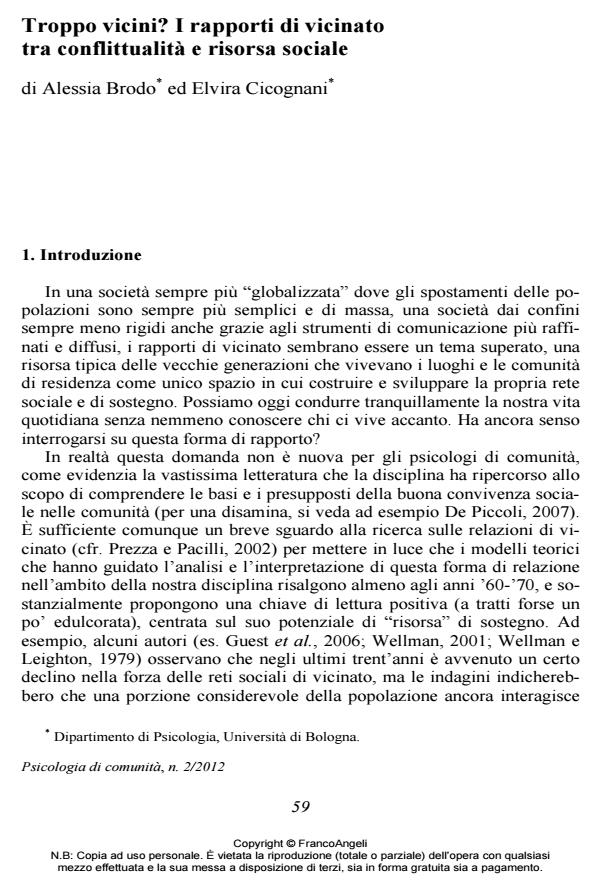Too much close? Neighbourhood relationships between conflicts and social resources
Journal title PSICOLOGIA DI COMUNITA’
Author/s Alessia Brodo, Elvira Cicognani
Publishing Year 2013 Issue 2012/2
Language Italian Pages 11 P. 59-69 File size 349 KB
DOI 10.3280/PSC2012-002006
DOI is like a bar code for intellectual property: to have more infomation
click here
Below, you can see the article first page
If you want to buy this article in PDF format, you can do it, following the instructions to buy download credits

FrancoAngeli is member of Publishers International Linking Association, Inc (PILA), a not-for-profit association which run the CrossRef service enabling links to and from online scholarly content.
Conflicts arising in the context of neighbourhood relationships constitute a problem that challenges community psychologists interested in enhancing the quality of social relationships among citizens, a central aim of social inclusion policies attempting to combat poverty and social exclusion. In this contribution, after briefly discussing research studies on neighbourhood relationships, we present an intervention of social mediation conducted in the territory of Cesena, with the aim to prevent and manage social conflicts, describing the data of a study aimed to evaluate the needs of the community and the impact of the interventions conducted.
Keywords: Neighbourhood relationships, conflict, social mediation, community interventions, social network, support.
- Castelli S. (1996). La mediazione, Teorie e tecniche. Milano: Raffaello Cortina
- Chiodini L. (2011). L’abitare sociale. Strategie locali di lotta alla povertà: città a confronto. Cittaitalia – Fondazione ANCI ricerche
- De Piccoli N. (2007). Individui e contesti in psicologia di comunità. Milano: Unicopli
- Guest A.M., Cover J.K., Matsueda R.L., Kubrin C.E. (2006). Neighbourhood context and neighbouring ties. City and Community, 5: 363-385
- Guest A.M., Wierzbicki S.K. (1999). Social Ties at the Neighborhood Level: Two Decades of GSS Evidence. Urban Affairs Review, 35: 92-111
- Mutti A. (1992). Il buon vicino. Bologna: Il Mulino
- Morineau J. (1998). Lo spirito della mediazione. Milano: Franco Angeli
- Mutti A. (1992). Il buon vicino, rapporti di vicinato nella metropoli. Bologna: Il Mulino
- Prezza M., Costantini S. (1998). Sense of community and life satisfaction: Investigation in three different territorial contexts. Journal of Community and Applied Social Psychology, 8: 181-194
- Prezza M., Amici M., Roberti T., Tedeschi G. (2001). Sense of community referred to the whole town: Its relations with neighbouring, loneliness, life satisfaction and area of residence. Journal of Community Psychology, 29: 29-52.
- Prezza M., Pacilli G. (2002). Il vicinato. In: M. Prezza, M. Santinello (a cura di), Conoscere la comunità. Bologna: Il Mulino
- Skjaeveland O., Garling T. (1997). Effects on interactional space on neighbouring. Journal of Environmental Psychology, 17: 181-198
- Stokoe E., Wallwork J. ( 2003). Space invaders: The moral-spatial order in neighbour dispute discourse. British Journal of Social Psychology, 42: 551-569.
- Unger D.G., Wandersman A. (1985). The components of neighbors: the social, cognitive and affective components of neighboring. American Journal of Community Psychology, 13, 2: 139-69
- Unger D.G., Wandersman A. (1983). Neighbouring and its role in block organisations: An exploratory report. American Journal of Community Psychology, 11: 291-300
- Wellman B. (2001). Physical Place and Cyber Place: The Rise of Networked Individualism. International Journal of Urban and Regional Research, 25: 227-52.
- Wellman B., Leighton B. (1979). Networks, Neighborhoods, and Communities. Urban Affairs Quarterly, 14: 363-390.
Alessia Brodo, Elvira Cicognani, Troppo vicini? I rapporti di vicinato tra conflittualità e risorsa sociale in "PSICOLOGIA DI COMUNITA’" 2/2012, pp 59-69, DOI: 10.3280/PSC2012-002006